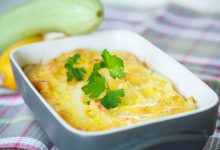🥧 Always Perfect Pie Crust 🥧
History 📜:
The art of making pie crust dates back centuries, with the first recorded recipe for a pastry crust appearing in a Roman cookbook in the 1st century AD. However, the concept of an “Always Perfect Pie Crust” is a modern adaptation of traditional techniques. It aims to create a foolproof and consistently delicious pie crust every time.
Components 🧁:
The components of an Always Perfect Pie Crust are simple:
- Flour: All-purpose flour is commonly used.
- Fat: Typically, butter and/or shortening are used for their distinct flavors and flakiness.
- Salt: For seasoning.
- Water: To bind the ingredients together.
- Sometimes sugar: Depending on the type of pie you’re making, a small amount of sugar may be added for sweet pies.
Steps to Prepare 🥣:
-
Gather Ingredients: You’ll need 2 1/2 cups of all-purpose flour, 1 cup (2 sticks) of cold unsalted butter, 1 teaspoon of salt, and 6-8 tablespoons of ice-cold water.
-
Cut the Fat: Cut the cold butter into small cubes and place them back in the refrigerator for a few minutes to keep them as cold as possible.
-
Mix Dry Ingredients: In a large bowl, combine the flour and salt.
-
Incorporate Fat: Using a pastry cutter or your fingertips, work the cold butter into the flour until the mixture resembles coarse crumbs.
-
Add Water: Gradually add ice-cold water one tablespoon at a time, mixing lightly with a fork until the dough just comes together. Be careful not to overmix; you want visible bits of butter.
-
Form a Disk: Turn the dough out onto a floured surface and gently shape it into a disk. Wrap it in plastic wrap and refrigerate for at least 30 minutes to let the dough rest and firm up.
-
Roll Out the Crust: After chilling, roll the dough out on a floured surface into a circle, about 1/8 to 1/4 inch thick, depending on your preference.
-
Transfer to Pie Pan: Carefully transfer the rolled-out dough to your pie pan, pressing it gently into the bottom and up the sides.
-
Trim and Crimp: Trim any excess dough hanging over the edges and use your fingers to create a decorative edge (crimp) around the rim of the crust.
-
Prebake or Fill: Depending on your pie recipe, you can either prebake the crust or add your desired filling and bake according to the specific pie instructions.
Time Needed ⏱️:
The preparation time for an Always Perfect Pie Crust can vary, but it typically takes around 15-20 minutes to prepare the dough, followed by a minimum of 30 minutes of chilling time. The total time depends on your pie recipe and whether you need to prebake the crust before adding the filling. Plan on at least 1 to 1.5 hours for the entire process.
Remember, practice makes perfect when it comes to pie crusts, so don’t be discouraged if your first attempt isn’t flawless. With time and experience, you’ll master the art of creating an Always Perfect Pie Crust that’s both delicious and visually appealing. 🥧✨
I’m happy to provide some general nutrition facts and health information for a basic pie crust recipe. Please note that specific values may vary depending on the exact ingredients and quantities used:
Nutrition Facts for Pie Crust (per serving, based on a typical recipe):
- Calories: Approximately 200-250 calories per serving (1/8th of a pie)
- Total Fat: About 12-15 grams
- Saturated Fat: Approximately 7-9 grams
- Cholesterol: Around 20-30 milligrams
- Sodium: Typically less than 200 milligrams
- Total Carbohydrates: About 20-25 grams
- Dietary Fiber: Minimal (less than 1 gram)
- Sugars: Usually very low (less than 1 gram)
- Protein: Less than 2 grams
Health Information:
-
Caloric Content: Pie crusts are relatively high in calories due to the butter and flour. They should be enjoyed in moderation as part of a balanced diet.
-
Fats: Pie crusts contain saturated fats from butter or shortening. While these fats can add flavor and flakiness, it’s important to limit saturated fat intake for heart health. Consider using healthier fats like olive oil or canola oil for a lighter crust.
-
Cholesterol: The cholesterol content in a pie crust is relatively low, but it’s still a consideration if you have dietary restrictions. You can reduce cholesterol by using less butter and more water in your recipe.
-
Sodium: The sodium content in pie crusts is typically low. However, be mindful of any added salt in the recipe if you’re on a low-sodium diet.
-
Carbohydrates: Pie crusts are primarily made of carbohydrates from the flour. They are not a significant source of fiber, so pair your pie with fiber-rich fillings for a balanced meal.
-
Sugars: Traditional pie crusts have minimal sugar content. If you’re making a sweet pie, the majority of the sugar will come from the filling.
-
Protein: Pie crusts are not a significant source of protein. You’ll get most of your protein from the pie filling.
Remember that the overall healthiness of a pie depends on its filling. Fruit-based pies with fresh fruit and limited added sugar are a healthier choice compared to pies with heavy cream or sugary fillings. Enjoy pie in moderation and as an occasional treat rather than a daily indulgence for a balanced diet.



